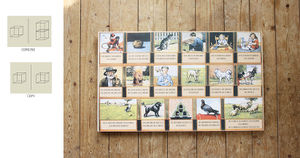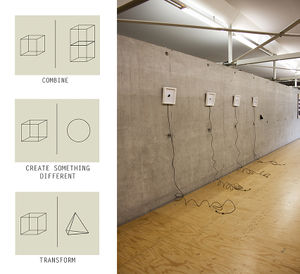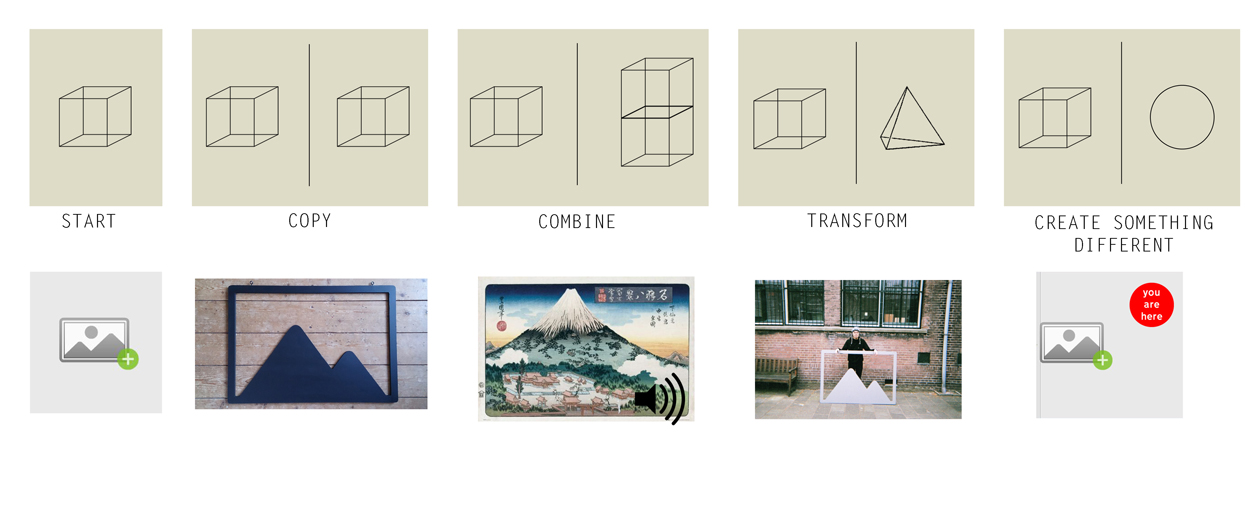Text on Uncreative Method
UNCREATIVE METHOD
Introduction
Solange Frankort works within an array of subjects within media, art and technology. She uses digital objects to reflect relationships between humans and the systems they create. With a little humor and irony, she creates a social dialogue about media and the digital age. Creating an unexpected and contrarian perspective to give a different awareness and perception. By questioning the intimacy between us and our digital objects, like the screen of our phone, we see these devices as objects, but how is this intimacy established between our screens and us?
Works
‘Binary Leesplankje’
A leesplankje van Hoogeveen, is a wooden plank of Dutch origin with images and below the definition like the words monkey, nut, sheep, ect.. This is a tool to learn Dutch, and they are typically found at primary schools. Children start at an early age to work with computers and digital devices, so they don’t only learn words, but also computer language. I’ve replace the words with binary code descriptions which fits to the images. For example, Aap (monkey) becomes ‘01100001 01100001 01110000’. The work is a reflection on how early children start to play with digital devices, and how quickly they learn to work with it.
The board is made of wooden with a printed photo on top. The first version, the prototype, was a original leesplankje where I glued the new binary names on it. I created a new version because I didn’t make the board myself. As a fine artist, I’m a maker, a creator of things, and by making them with my own hands, I create new work. I use existing objects or digital information as an inspiration to create. Like the binary code I look up on the Internet, I combine digital information to something physical. I made a copy of the leesplankje with slightly different information.
‘Touch Screen has Replaced Me’
Touchscreen has replaced me is a project that notice a shift in devices, from keyboards to touch screens. My first mobile phone was with a keyboard, nowadays all the mobile phones have a touch screen. In this project, I want it to give the keys of a keyboard a nostalgic feel, a history, a memorable piece. By framing in the keys they get a kind of memorable feel, like you already lost them. As if you’re already lost the Walkman or Floppy disk, you are going to lose the keyboard someday, I’m showing something what’s going to happen.
The cable out of the frame shows you what remains existence. The function of the key is to type in certain characters what appears to the screen. By plugging the cable to you digital device, you will see the key you’ve chosen. For example, the frame with the ‘J’ key shows you the ‘J’ on a text file. The digital ‘J’ will continue existing, but not the ‘J’ –key. Again using existing things combine with digital information, to create a story what not has happened yet.
I have a non- linear method that I follow within all my projects. I’m really focusing on the way of working, on the process. I’m going to work with this method for each project to see what happens. Also, when you’re stuck within your process, you just grab the method and choose an ingredient to go further. In this project example I’m going to explain more about the method that I use in all of my projects. Maybe you notice it already, like the words; combine, copy, create something different.
‘The Journey to Fuji’
The symbol of ‘two mountains’ represents the ‘empty placeholder‘ or a symbol of an image. What does that say? What kind of language is it? Where does the symbol come from? It’s not just a sign. It becomes more than that, it starts a conversation. By researching all the different symbols from mountains I bump in to the symbol of landscape mode on a camera. At medially I so a connection with the Fuji Camera and the Fuji Mountain in Japan. I was never sure if the symbol comes from there, but I came up with a fiction-facts story about the mountain-symbol. In combination with the installation it’s creates a kind of Japanese- myth experience. I wanted to change the context of the symbol, and the point of view of the ‘two mountains’ so it starts a conversation.
First a started with the symbol from the so called ‘template photobook’ what I made. Then I made a copy, the symbol as a physical object. After that I combine a Japanese mythology with my story where the symbol comes from. By creating a fiction and facts audio story around the symbol and the mountain Fuji. Transforming the symbol to something larger and make tourist photos with my mountain I almost completed the method. Create something different out of the start is the template room. Placing the symbols in a room creates the living template. This process was non-linear and the terms are optional, you don’t have to use them all.
Method
So you have a start, and you have your ingredients, but you don’t have to use everything. But I notice that I’m using all the ingredients to complete the work. So I start, I copy, I combine, I transform, and I create something different than the sum of what I started with. This process feels natural. But now, I know I still want it to be spontaneous because normally, I do this without knowing. Now, the steps have become so clear that I have the desire to put some spontaneity back in my method. I worry there is a danger in becoming too mathematical.
Context
After some exhibition people called my work ‘Post-Internet Art’. I’m not sure I fit in that category, but I see some great similarities with the theory what people write about the so called term ‘Post-Internet Art’.
This vague term started all when Marisa Olsen mention it in an interview somewhere between 2007 and 2009. The Internet, of course, was not over. Rather, let’s say this: what we mean when we say ‘Internet’ served as shorthand for this change. This term developed further by the writer Gene McHugh in the critical blog ‘Post-Internet’ during 2009 and 2010. It is still vague because it’s so new, and it’s often associated with New Media Art and Conceptualism.
“What I make is less art "on" the Internet than it is art "after" the Internet. It's the yield of my compulsive surfing and downloading. I create performances, songs, photos, texts, or installations directly derived from materials on the Internet or my activity there”. (Olson, 2006)
Olson uses the term in a sense that after using the internet, she makes art. On some general level, the rise of social networking and the professionalization of web design reduced the technical nature of network computing, shifting the Internet from a specialized world for nerds and the technologically-minded, to a mainstream world for nerds, the technologically-minded and grandmas and sports fans and business people and painters and everyone else. Here comes everybody. (Mchugh, 2011)
According to Droitcour, Post-Internet art is about creating objects that look good online. (Droitcour, 2014) I disagree, Post Internet Art can also be off-screen work made by the influence of the internet. Post-Internet objects and images are developed with concern to their particular materiality as well as their vast variety of methods of presentation and dissemination. (Vierkant, 2010)
“The artist’s practice, being a combination of technology as material – digitally printed plastic – and technology as a source of idea and image, is distinctly Post-internet”.- (Jean. 2014)
“Post- whatever epochs seem to happen more and more frequently. The word suggests a shift, a time of change or perception”. - (Gens, 2014)
So let’s go back to my practice and what does the term has to do with me? I’m not sure Post-Internet Art is the right name, but the important part of it; making art after using the internet – fits right up my ally. Maybe when there was no internet, I wasn’t an artist. My work is influence by this digital age and to find my sources I use the internet.
The ‘good online’ or ‘off-screen’ part it seems not that important for the term Post-Internet art. Like Folks says; “It reflects the notion that it is not the style nor the content of the works at play here, nor even their chosen medium or mediums, but rather the interconnectivity between ideas and forms, the very practice of creativity and the process by which it is realised.” – (Folks, 2014)
On a screen or off screen, my work could be both, it’s depended of the idea. Often it’s something physical, because we already spend so much time with the screen, searching for inspiration or influences, that to get off the screen feels like freedom. The handwork becomes a kind of freedom.
When makes it a work?
The work has to be finish in my eyes
The work involves some handwork
The work follows a non-linear method
The medium is an important part of the work
The work creates a social dialogue within the digital age
The work has a little humor or irony
I make art after using the internet





